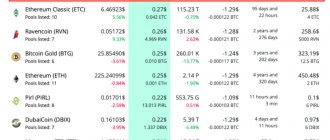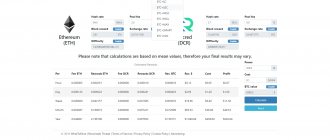Cryptocurrency mining is at the peak of popularity today and every day more and more people decide to try themselves in this area. However, it is difficult to deny that the mining industry is a rather difficult business, because in addition to the fact that a novice miner must have an entrepreneurial streak and understand the basics of doing business, he must also understand all the technical issues and details of the process.
For a beginner, understanding this topic can sometimes be very difficult, because the variety of incomprehensible terms sometimes confuses. If you want to start as soon as possible, without investing money and time in buying equipment and learning the intricacies of the process, try cloud mining. Now this method is more financially profitable, but if you want to get acquainted with independent mining on a CPU, then this article is for you.
What is CPU mining?
Cryptocurrency mining is the process of carrying out a series of complex calculations with enumerating parameters to find a hash with given properties. This process is quite complex, and accordingly, it requires impressive computing power.
Surely everyone has heard that mining on ASIC miners and video cards (or GPUs) is an excellent option for passive income, but the only thing you have most likely heard about mining on processors is that this option is far from the most profitable.
In past years, when the complexity of the network was different, it was enough to use a regular central processor to mine cryptocurrencies. Now the situation has changed and this option, as a rule, is not considered by miners at all, due to its low profitability.
A central processor is hardly enough for serious earnings, but for small altcoins CPU mining has a place, because in the context of the “size of initial investment” / “profitability” ratio, this option is the most optimal. Please note that if you are aiming for big profits, you will need to develop your business and switch to more productive equipment in time, or invest in cloud mining.
So, the central processing unit (or CPU) is an integrated circuit that is the main part of the hardware of a personal computer or any other equipment.
Currently, any modern, high-performance computer is equipped with a powerful central processor with high operating frequency and several cores. Accordingly, if you have a good personal computer, you won't have to invest hundreds or thousands of dollars in hardware.
The success of mining on a central processor is also determined by the cryptocurrency that you intend to mine. Of course, mining Bitcoin on a CPU is absolutely pointless, but there are digital currencies whose hashing algorithms are “tailored” for mining on processors, so it will be easier for your CPU to mine them. Such digital currencies include: Monero, ZCash, Dogecoin, Litecoin, Dash, Sibcoin, etc.
Currently, there are the following types of cryptocurrency mining on a processor:
- solo mining is the process of mining cryptocurrency using exclusively one’s own computing power without the involvement of other miners;
- work through the pool. A mining pool is a server that provides miners with the opportunity to jointly mine digital currencies (the computing power of the miners in this case is combined, and the reward for closing a block is distributed among the pool participants in proportion to their “contribution” to the pool);
- multipool is a server that allows you to mine several virtual currencies and switch between different cryptocurrencies, depending on their profitability (for example, Minergate, Nicehash, Zpool).
The concept of mining on a processor
This process is a series of complex calculations whose goal is to find a hash with specified properties. To summarize the essence of mining, it is the search for new blocks in order to receive a reward. Initially, mining was carried out on processors that allowed for the highest performance in the assigned tasks. Moreover, the CPU made it possible to successfully mine the top cryptocurrency - Bitcoin, which is considered the founder of mining.
Later, this niche was occupied by GPU mining, that is, mining on video cards. It turned out to be more productive, convenient and promising. Today, Bitcoin, Ethereum and other leading “coins” are no longer mined on processors. This is due to technical features and the increase in network complexity due to the influx of ASICs.
The capabilities of modern processors and architecture are developing and do not stand still, so it cannot be said that CPU mining has completely failed. However, it is worth considering the increase in network complexity, which has made processors the most disadvantageous devices. There are three options for CPU mining of “coins”:
- Solo – this type of mining involves the use of your own power. Today, it is completely a thing of the past due to the increasing complexity of production.
- Pools are a popular type of mining that involves bringing together a certain number of “miners” to increase overall productivity. Joint mining is the only way to restrain the monopoly of the cryptocurrency sphere and the opportunity to earn money even with insignificant (in terms of the overall complexity of the network) capacities.
- Multipools are services (servers) that allow you to mine “coins” using different algorithms by switching to the most profitable ones. It is considered the most widespread option for virtual “miners” (the simplest example is NiceHash).
It is important to note that with proper configuration of miners, on powerful CPUs with excess power (which is used in certain tasks) you can receive a stable income. Moreover, the system can be configured so that mining occurs at times when PC resources are not fully utilized. Also, CPU mining is a great way to get acquainted with the field of mining virtual “coins” without additional purchase of video cards and ASICs.
What cryptocurrency can be mined with a processor?
Currently, you can get the most income if you mine coins that work based on the Cryptonight cryptocurrency algorithm: Monero XMR, Bytecoin, Electroneum, DigitalNote, etc. In addition to this algorithm, the central processor is capable of decrypting the following algorithms:
- SHA-256 (bitcoin, Bitcoin Cash, Syscoin, Peercoin, Namecoin, etc.);
- x11 (currencies Dash, Pura, etc.);
- Ethash (currencies Ethereum ETH, Ethereum Classic, Metaverse ETP, Ubiq, etc.);
- Scrypt (currencies Litecoin, Dogecoin, etc.);
- Equihash (Zcash, Komodo, etc.).
See also: Cryptocurrency mining algorithms
Make no mistake, in theory you can mine all these cryptocurrencies, but in practice in most cases the game is simply not worth the candle.
Overall, as of now, the best options to consider are Monero, ZEC, and Dogecoin.
What cryptocurrency can be mined with a processor in 2020?
Potentially, it is possible to mine any cryptocurrencies using algorithms using PoW on the CPU.
Over the past few years, cryptocurrencies have also begun to appear that are adapted directly for CPU mining. Among such algorithms are Ethash, Zhash, CryptoNote, CryptoNight, and others. These algorithms are used to power digital coins that are promising for CPU mining, such as Monero, Dogecoin, ZCash, and Ethereum. Of course, you can mine a significantly larger number of different cryptocurrencies on a processor, for example, Binarium, Veco, GlobalBoost. But many coins are still at the stage of active development and cannot boast of high prices and liquidity, which makes their mining more risky.
Mining little-known cryptocurrencies with their subsequent storage and sale during a pump is a good way to increase mining profitability hundreds of times. But you need to understand that many coins may turn out to be scams.
To start mining, you need to complete three important points:
- Decide on mining equipment.
- Select and install all the software necessary for mining.
- Set up and start mining.
It may take some time to start mining, especially if you are new to mining, but don't worry. We have prepared detailed instructions, thanks to which even a novice miner can cope with the task.
Is it possible to mine Bitcoin on a processor?
In theory, BTC can be mined on a central processor, since it runs on the SHA-256 algorithm, which does not contradict this.
But in reality, the difficulty of Bitcoin mining has increased so much that mining on a CPU will not bring any results, except perhaps academic value.
Mining Monero on CPU
The anonymous cryptocurrency Monero (XMR) is considered one of the most profitable for CPU mining. Mining Monero shows impressive performance, especially when using powerful processors, such as Intel i7 or i9.
A high level of profitability is achieved due to the high cost of the coin. In addition, one of the advantages of XMR mining is high liquidity.
Let's assume that you have already stocked up on a suitable processor. The next step is to choose a safe place to store your coins. This can be a local Monero wallet, which you can download from the official website, or an online wallet on the exchange. In the latter case, you can also count on a quick exchange of mined coins for other digital assets or fiat money.
Next, you need to select a mining pool that allows you to mine Monero and is suitable in terms of total power and commissions. You need to register on the server and add a new worker.
The next step is to select and download a mining program. As a rule, this can be done from their official websites and pages on GitHub and BitcoinTalk. We install and unpack the software, configure it, enter wallet and pool data, and start mining. After some time, your wallet balance will begin to change.
Below we will look at each point step by step.
Ethereum Mining
Ethereum is the second most valuable cryptocurrency and many people are interested in mining it. Today, due to the high complexity of the network, Ether mining on a central processor is practically unprofitable. Effectiveness can only be achieved by using many powerful processors.
However, if you want to try it, you will need to follow similar steps to the previous section. You can download a local Ethereum wallet from the official website. In addition, its support has been added to almost all existing wallets and exchanges.
Mining Dogecoin on a CPU
The semi-joking coin Dogecoin (DOGE) is mined in a similar way. Just create a wallet, connect to the pool through the selected software and watch the result.
CPU mining ZCash
Anonymous Zcash (ZEC) is popular not only among hackers, but also among miners. The logic of organizing its production remains the same. Given its popularity, it won’t be difficult to find pools, exchanges and wallets that support Zcash.
Which processor to choose for mining?
Unfortunately, there is simply no clear answer to this question. The choice of processor depends on too many factors; accordingly, this process must be approached individually. One thing is safe to say - the more powerful the processor you choose, the higher the hashrate will be, which means that the performance of your mining equipment will be high, and the mining process itself will be profitable. This suggests that when choosing a processor, you should pay due attention to the following characteristics of the central processor:
- clock frequency;
- Number of Cores.
It is these parameters that will determine the hashrate. Currently, it is believed that one of the most promising options is the Xeon line of central processors. A processor from AMD or Intel (i3, i5, i7 series) would also be a good option. Below is a table of processor performance, which should help you in choosing the right equipment (the table shows the most popular CPU models).
Processor performance for mining
| CPU | Hashrate | Cores | Streams | Base frequency | Overclocking capability | L3 cache | TDP |
| AMD Ryzen Threadripper 1950X | Cryptonight hashrate: 1280 | 16 | 32 | 3.4GHz | 4.0GHz | 32MB | 180W |
| AMD Ryzen 7 1800X | Cryptonight hashrate: 660 | 8 | 16 | 3.6GHz | 4GHz | 16MB | 95W |
| Intel Pentium G4400 | Cryptonight hashrate: 62 | 2 | 2 | 3.3GHz | N/A | 3MB | 54W |
| AMD Ryzen 5 1600X | Cryptonight hashrate: 503 | 6 | 12 | 3.6GHz | 4GHz | 16MB | 95W |
| AMD Ryzen Threadripper 1920X | Cryptonight hashrate: 1068 | 12 | 24 | 3.5GHz | 4GHz | 32MB | 180W |
| Intel Core i5-7600K | Cryptonight hashrate: 260 | 4 | 4 | 3.8GHz | 4.2GHz | 6MB | 91W |
| Intel Pentium G4560 | Cryptonight hashrate: 65 | 2 | 4 | 3.5GHz | N/A | 3MB | 54W |
| AMD Ryzen 3 1300X | Cryptonight hashrate: 270 | 4 | 4 | 3.5GHz | 3.7GHz | 8MB | 65W |
Mining Monero on CPU
So, let’s move on directly to the issue of mining Monero. Let's look at the processor first; an undeniable advantage is that when mining Monero on a processor, significantly less electricity is wasted.
To get started, download and install the minergate program if you decide to mine on a processor.
It is convenient because even a beginner can understand it.
To do this, follow the link to the official website and first of all register your account. We confirm your email and log in with your username and password.
Next, go to the download tab and download the program itself, there are 32 and 64-bit options to choose from, so you shouldn’t have any problems with this.
After downloading, install minergate, as shown in the figure below.
We launch the program, enter your email in the field, which you indicated when registering in the system.
And we actually get into the miner, where you can select the monero coin (xmr) and click on start, it all depends on the processor power of your computer. There are other cryptocurrencies available for mining.
For those who want to receive step-by-step instructions on this program, how to withdraw mined funds and use cloud mining to increase profits, then register using this link in minergate and write to me at [email protected] with the subject “Mining minergate”.
In the text of the letter, be sure to indicate your nickname in the system, to receive it, go to Panel - Profile (as shown in the figure below), in the nickname field, create and enter your nickname, click save.
How to choose a program for mining on a processor
As a rule, insufficient attention is paid to the choice of software, but believe me, the right mining program is a very important detail in the context of mining profitability and half of your success.
For those who do not understand what we are talking about, let us clarify the situation. A cryptocurrency mining program is a specially designed software that allows you to use the computing power of your equipment. The main task of this type of program is to carry out calculations to obtain rewards for developing blocks.
It makes sense to select software for mining digital currencies only after you have decided exactly what kind of cryptocurrency you will mine. Miner programs are designed specifically for mining a specific (or several) virtual currencies (see table below). All programs are freely available on the Internet, so, for example, you can download the software from the Github website. (In addition, there are programs that allow you to simultaneously mine on a processor and a video card).
| Cryptocurrency mining program | Cryptocurrency |
| CPU miner (pooler) | Litecoin |
| 50MINER | Bitcoin, Litecoin |
| Ufasoft Miner | Roll-Ntime, TeneBrix, SolidCoin, BitForce |
| Jgarzik CPU miner | Bitcoin |
| GUI miner (Phoenix+Poclbm) | Bitcoin |
| Eobot | Bitcoin, Dogecoin |
| CG Miner | Bitcoin |
| Nheqminer | ZCash |
| Diablo Miner | Bitcoin |
| Nice Hash Miner | Different cryptocurrencies |
| Wolf's CPU Miner | Monero, Bytecoin, Electroneum, DigitalNote |
| Claymore CPU Miner | Monero, Bytecoin, Electroneum, DigitalNote |
| Yam CPU | Monero, Bytecoin, Electroneum, DigitalNote |
Modern CPU mining
Many mining veterans who have serious computing power ignore the CPU, since the profit from them is a fraction of a percent of the total profit.
This is due to the complexity of computing those cryptocurrencies that are traded in the TOP 10 of the world list.
Those users for whom mining is new and every cent of earnings brings them closer to a new expansion of capacity do not ignore mining on the processor.
And it's coming back into fashion again, in part because mining high-value coins requires more computing power, hence a faster processor to support it.
Another factor influencing the return of popularity of mining on a processor is new cryptocurrencies that are constantly appearing. Some of them do not reach a critical mass to begin circulation on crypto exchanges, others trade there for a short time and disappear, but some shoot up and bring their holders a huge profit, in the form of hundreds and sometimes thousands of percent of the resources spent.
go
How to set up mining on a processor
In order to start mining any cryptocurrency on the processor, you will need to perform certain actions in a specific sequence. Setting up will not take you much time and is not particularly difficult, which means that even a beginner can easily cope with this task. So, the whole process takes place in four stages:
- Processor selection;
- Installing a cryptocurrency wallet;
- Selecting and installing a program;
- Creating a bat file and launching it.
At the first stage, you will need to select a powerful central processor. How to approach this issue correctly has already been mentioned earlier. You should also choose a good motherboard, fast RAM, connect a hard drive, power supply and monitor. When choosing a processor, you must definitely pay attention to how much electricity your processor will consume, because the profitability of mining will depend on this parameter. If your CPU is uneconomical in terms of electricity consumption, then, alas, most likely you will not be able to earn a penny, or even you will go into the red. Pay attention to eight- and sixteen-core processors from AMD with high clock speeds; Mining on a server CPU will increase your chances of profit (see CPU performance table above). Look for additional information on the Internet (on forums, for example), look at the rating of processors in terms of their performance and energy efficiency.
In the second step, you will need to install a cryptocurrency wallet. To do this, you will need to go to the official website of the cryptocurrency of your choice and download a special wallet program from this site. It is to this wallet that the coins you mined will be sent, and then you can either store this digital money in this wallet or withdraw it. On official websites, as a rule, there are links to download wallets for various software; you will need to select exactly the file that suits you, click on the desired link and the download will begin automatically. After you download and install your wallet program, you will need to sync it with the network and find out your wallet address.
At the third stage , you have to select and install a miner program. We have already talked about how to choose the right software. Please note that your miner program must be suitable for the virtual currency you have chosen. You can download this software from the network, for example, from the Github website. Download links will be posted there, you will need to select the version of the software you are interested in, click on the link and the download of the program will begin automatically. Then you will install the program on your personal computer. Now all you have to do is configure your software.
At the fourth stage , you will need to create a file with a bat extension and start mining. A file with the bat extension is a file that specifies the main parameters of the process of mining digital currencies, and is responsible for launching the miner program with the specified configurations. In particular, the following parameters are written in this file: path to the exe file of the program, pool address, port, wallet address, type of computing architecture, miner number, password, etc. For different programs and pools, the list of characteristics usually differs, but not dramatically.
You can create a file with the bat extension in Notepad. You work with a standard text file, enter all the settings, and then save this file in bat format.
Mining Monero on CPU
So, as we have already found out, the most optimal option is mining the Monero cryptocurrency. In order to start mining Monero on CPU, you need:
- directly the central processor itself;
- a cryptocurrency wallet where the coins you mined will be sent;
- mining pool;
- software (miner program).
Let's assume that you have already chosen the hardware. Now you have to choose a cryptocurrency wallet. You can use a local wallet, or you can use a wallet on the exchange. The second option is more preferable, since you can quickly withdraw the coins you mined into fiat or buy another cryptocurrency. Choose exchanges with a user-friendly interface, convenient deposit and withdrawal of funds, as well as built-in withdrawal methods to a card or Qiwi wallet. You can choose the option that suits you using our list of exchanges. You will need to register on the exchange and in your personal account you can copy the wallet address.
Then you will need to select a mining pool. You can choose any pool that suits you in terms of commission and power. Register in the pool, add a new worker and enter your wallet address.
Now all you have to do is download the necessary software. We have previously written about what programs you can use for Monero. You will need to download the miner program of your choice, unpack it to a convenient location and open the config.txt file. In notepad you should write down the following text:
“-o and then the address of your pool. -u followed by your wallet address. -p and then the password, for almost all pools you should leave x.”
Then you will need to save this file with bat extension and run the bat file. If you did everything correctly, then mining on the processor has already begun. After waiting a little time, you will be able to view your mining statistics. To do this, you will need to go to your pool’s website, enter your wallet address, and you will see a graph that will display mining statistics: your current hashrate, balance, etc.
Setting up Dogecoin mining on a processor
Setting up Dogecoin mining is done in a similar way. First, you will need to create a wallet and find out its address. Then you will need to register on one of the pools, add a new worker, enter your wallet address and update your account. Now all that remains is to select a suitable miner program, download it, install it on your personal computer and configure it. To do this, you will need to create a file with a .bat extension with the following text:
"minerd -url=stratum+tcp://fast-pool.com:3333 -userpass=Weblogin.Worker:Worker password."
Save the file, launch the software and, if you did everything correctly, the process will start.
CPU mining Zcash
Another digital currency that you can mine on your CPU is the Zcash cryptocurrency. The logic of organizing the process remains the same. First, you select a wallet and find out its address. Then select a pool, register there, indicate your wallet address in your personal account and update your account. Next, proceed to selecting software, download the program and install it on your computer. The best option in the context of Zcash mining would be nheqminer. You can download this software from the Github website, for example. Now you will need to move on to editing the bat file. Your file should contain the following text:
"nheqminer.exe -l -u . "<\/worker><\/address>
Save the changes, run the bat file and, if you did everything correctly, the process will start.
Mining on Xeon processor
Bitcoin mining
The Intel Xeon processor family is a server line of high-performance CPU models known for their reliability and performance.
In some cases, mining on Intel Xeon server processors is significantly ahead of the same activity on the Intel i7 and i9 family of desktop processors. Thus, the server model Intel Xeon E5-2650 shows a decent result for a CPU of 143 kH/s, while the desktop model Intel Core i7-3960X shows only 101 kH/s.
For comparison: the Nvidia GeForce RTX 2080 Ti video card shows a result of 52.5 Mh/s.
Setting up the mining procedure on a server CPU is no different from setting up desktop models. You need to launch the graphical interface of the program, specify the necessary data there and start the mining process.
CPU and GPU mining: main differences
As has been mentioned many times before, mining on a CPU is in most cases low-profit and in many ways inferior to mining on a GPU. Beginners may have a question: what is the difference between a CPU and a GPU, if both the first and the second are processors?
In theory, both CPUs and GPUs are processors, but they are two different types of processors that perform different types of tasks.
CPU (or central processing unit) is a piece of hardware in a personal computer or any other hardware that is responsible for executing software tasks and that controls all other components of the personal computer or any other hardware. This is a kind of leader who makes decisions and gives commands.
GPU (or graphics processor) is a piece of hardware of a personal computer or any other equipment that is responsible for processing graphics and displaying images on the monitor of the user of a personal computer or any other equipment. This is a kind of simple hard worker who does a lot of work.
Accordingly, as you may have already noticed, these two types of processors are designed to perform tasks of varying complexity, which determines the difference in the performance of both types of processors. Thus, the CPU core is capable of processing four 32-bit instructions per clock (SSE), or eight 32-bit instructions per clock (AVX), while the GPU processes 3200 32-bit instructions per clock (using its 3200 ALUs or shaders). Consequently, the performance of the GPU is hundreds of times higher than the performance of the CPU, and in the context of mining, even a small difference makes a difference, let alone such a huge one.
In addition to performance, the central processor differs from the graphics processor in the way it accesses memory (we won’t go into technical details). In addition, the GPU, unlike the central processor, does not need a large cache memory. Another significant difference is that the GPU uses a faster type of memory, which means that the throughput of such a processor will be an order of magnitude higher, which is very important for parallel computing. Thus, the central processor is capable of carrying out only one or two threads of calculations on one core, while the graphics processor is capable of carrying out thousands of threads on each multiprocessor (and there are several of these on the chip!).
So, from a technical point of view, the difference between these two types of processors is simply huge, which determines such a difference in the performance of this hardware in the context of cryptocurrency mining.
Differences in mining between CPU and GPU
The processor core is capable of processing 4 32-bit, or 8 32-bit, depending on the selected clock cycle (clock frequency is the interval between two pulses, which makes it possible for the equipment to perform several operations), and let’s say a video card is capable of processing 3150 32-bit instructions in the same tact. The result is that mining on a video card is 800 times more profitable than on a processor.
But what about processors with 12, 8 or 6 cores? Surely they are a mining bomb? Alas, even a relatively weak video card will be several times stronger than them, so you shouldn’t seriously consider them as an alternative.
Table of processor performance in mining
| Model | Speed(kH/s) | (GHz) | Cores |
| Xeon X5450 | 22 | 3.00 | 4 |
| Xeon L3426 | 19.36 | Jan.87 | 4 (8 HT) |
| Xeon E5620 | April 26 | Feb.40 | 4 (8 HT) |
| Xeon E5504 | 42 | 2.00 | 2×4 |
| Xeon E5405 | 18.Aug | 2.00 | 4 |
| Xeon E5-2650 | 129.30 | 2.00 | |
| Xeon E5-2630L | 41 | 2.00 | 6 (12 HT) |
| Xeon E5-2620 | 93.91 | 2.00 | |
| Xeon E5-1650 | 64.61 | Mar.20 | 6 (12 HT) |
| Xeon E5-1620 | 50.18 | Mar.60 | |
| Xeon E3-1230 | 44.4 | Mar.20 | 4 (8 HT) |
| Xeon E3-1220 | 40.50 | 03.Oct | 4 (1HT) |
| Xeon 5160 | 17 | 3.00 | |
| Xeon 5160 | 20.79 | 3.00 | |
| Pentium M 740 | 0.8 | Jan.73 | 1 |
| Pentium M | Jan.23 | Jan.60 | 1 |
| Pentium Dual T3400 | 08.May | Feb.16 | 2 |
| Core i7-920 | 37 | Feb.67 | 4 (8 HT) |
| Core i7-920 | 41 | 4.00 | 4 (8 HT) |
| Core i7-870 | 35.4 | Mar.40 | 4 (8 HT) |
| Core i7-860 | 25 | Feb.80 | 4 (8 HT) |
| Core i7-740QM | 16 | Jan.73 | 4 (8 HT) |
| Core i7-4770 | 80 | Mar.40 | 4 |
| Core i7-4770 | 93 | Mar.40 | 4 (8 HT) |
| Core i7-4770 | 95 | Mar.40 | 4 (8 HT) |
| Core i7-3960X | 101 | Apr.29 | 6 (12 HT) |
| Core i7-3930K | 98 | Apr.50 | 6 (12 HT) |
| Core i7-3770 | 60 | Apr.38 | 4 (8 HT) |
| Core i7-3720QM | 37 | Feb.60 | 4 (8 HT) |
| Core i7-3720QM | 42 | Feb.60 | 4 (8 HT) |
| Core i7-3630QM | 39 | Mar.29 | 4 (8 HT) |
| Core i7-2760QM | 38 | Feb.40 | 4 (8 HT) |
| Core i7-2700K | 50 | Mar.90 | 4 (8 HT) |
| Core i7-2630QM | 16 | 2.00 | 4 (8 HT) |
| Core i7-2630QM | 21 | 2.00 | |
| Core i7-2600K | 49 | Apr.60 | 4 (8 HT) |
| Core i7-2600 | 47.15 | Mar.40 | 4 (8 HT) |
| Core i5-750 | 30 | Mar.30 | 4 |
| Core i5-650 | 17.18 | Mar.20 | 2 (4 HT) |
| Core i5-520M | 12 | Feb.40 | |
| Core i5-3570K | 55 | Apr.50 | 4 |
| Core i5-3470 | 43 | Mar.20 | 4 |
| Core i5-2500T | 28 | Feb.40 | 4 |
| Core i5-2500K | 31 | 5.00 | 4 |
| Core i5-2500K | 48 | Apr.90 | 4 |
| Core i5-2467M | 12 | Jan.60 | 4 |
| Core i5-2400S | 32.8 | Feb.50 | 4 |
| Core i3-540 | April 15 | 03.Jun | 2 (4 HT) |
| Core i3-450 | 15 | Feb.90 | |
| Core i3-2130 | 23 | Mar.40 | 2 (4 HT) |
| Core i3-2120 | May 21 | Mar.30 | 2 (4 HT) |
| Core i3-2100 | 19 | 03.Oct | 2 (4 HT) |
| Core 2 Quad Q9550 | May 27 | Feb.83 | 4 |
| Core 2 Quad Q9550 | 32.2 | Mar.40 | 4 |
| Core 2 Quad Q8400 | June 21 | Feb.66 | 4 |
| Core 2 Quad Q6600 | Sep.68 | Feb.40 | 4 |
| Core 2 Extreme QX9775 | 29.2 | Mar.20 | 4 |
| Core 2 Duo T9500 | 17.76 | Feb.60 | 2 |
| Core 2 Duo T7500 | 06.May | Feb.20 | 2 |
| Core 2 Duo T7250 | 5 | 2.00 | 2 |
| Core 2 Duo T7250 | 6 | 2.00 | |
| Core 2 Duo T6570 | Sep.52 | 02.Oct | |
| Core 2 Duo T5500 | Jul.28 | Jan.66 | 2 |
| Core 2 Duo MacBook Pro 5.2 (2009) | 11 | Feb.80 | |
| Core 2 Duo E7500 | 13.jan | Feb.93 | 2 |
| Core 2 Duo E7300 | 7 | Feb.70 | 2 |
| Core 2 Duo E6600 | Oct.45 | Feb.40 | 2 |
| Core 2 Duo E4300 | Mar.25 | Jan.80 | |
| Core 2 Duo E2200 | Sep.20 | Feb.90 | 2 |
| Celeron 440 | 4 | 2.00 | 1 |
| Atom N450 | Feb.61 | Jan.66 | 1 |
| Atom N2800 | May.81 | Jan.87 | 2 (4 threads) |
| Atom N270 | Feb.57 | Jan.66 | 1 |
| Atom N270 | Feb.78 | Jan.80 | |
| Atom N2600 | Apr.88 | 01.Jun |
Keep in mind that processors will produce different speeds using different algorithms.
As you can see, the speed is calculated in kH/s, while the speed for video cards is calculated in Mh/s (video card hashrate table), what does this mean? And the fact that 1 MH/s = 1,000 kH/s, which means the speed of mining the treasured cryptocurrency coins is thousands of times faster.
Also, mining speed can be measured in the following quantities:
- 1 GH/s - gigahash;
- 1 TH/s - terahesh;
- 1 PH/s - petahash;
Profitability of mining on a processor
Then a completely logical question arises: is there any point in mining on a central processor? In order to get an answer to this question, you need to calculate the profitability.
In general, the profitability of mining on a processor is affected by the following parameters:
- the performance of your hardware (in this case, the central processor);
- cost of equipment (if you purchase specific equipment specifically for your purpose, then you will definitely need to take this amount into account when calculating the payback of your business);
- electricity tariff (it makes sense to start only if cheap electricity is available);
- the price of the cryptocurrency you are going to mine;
- the complexity of the cryptocurrency network you intend to mine.
Of course, you don’t have to do the calculations yourself. You can make your task much easier and use a mining profitability calculator. You will need to indicate the name of the desired cryptocurrency, the hashrate of your device and your electricity tariff. The calculator itself will calculate the profit that you can get on a specific processor.
In general, we can safely say that you should not expect huge profits. For example, mining the Monero cryptocurrency on top-end powerful processors can earn you approximately 10 to 40 cents per day, provided that the cost of electricity in your country (or region) is low enough. Mining Litecoin on high-performance processors can generally only bring in less than a dollar per month. Of course, such a profit is so insignificant that the process itself becomes meaningless. For Litecoin, it is better to choose other equipment - an ASIC miner or assemble a farm.
Accordingly, only after making accurate calculations will you be able to answer the question whether the game is worth the candle or not.
CPU mining calculators
Calculating the profitability of mining on a processor CPU
mining calculators provide information with a detailed calculation of the profitability of mining cryptocurrencies. As a rule, these are the same online platforms that calculate the cost of mining for video cards and ASICs. Based on certain algorithms and cryptocurrency quotes, these services calculate the profitability of mining in real time, i.e., according to the current cryptocurrency exchange rate.
The services are designed according to a simple principle: you enter the name of the central processor model, the cost of electricity in your region and receive a list of the required cryptocurrencies, usually with detailed information about which of them is the most profitable in a given period of time.
☝️
Read the full article: Mining calculator: how to calculate the profitability of Bitcoin and cryptocurrencies
A list of the most convenient calculators for mining on a processor is below.
NiceHash
☝️
Link to NiceHash calculator
An excellent mining calculator that initially provides calculations for the associated cloud mining service and marketplace for trading remote mining capacity. Simple, clear and convenient. The service supports as many as 24 algorithms.
As an example of using a mining calculator, we will calculate mining on two different central processors, two desktop ones from Intel and AMD, and one server one using the NiceHash calculator.
We will take the best models with high performance for the most up-to-date picture possible.
The first example: the top-end central processor from AMD - AMD CPU Threadripper 1900X.
Mining income calculation on AMD CPU Threadripper 1900X processor
As we can see, even if mining on a very powerful processor provides profitability, it is very relative, especially compared to the same indicators from video cards and ASICs.
Second example: a central processor from Intel - Intel CPU i9-9980XE:
Calculation of mining income on the Intel CPU i9-9980XE processor
The screenshot shows that in the case of even such a powerful processor, mining on central processors, even if it has profitability, is very relative.
☝️
Read the full article:
My Crypto Buddy
An excellent calculator for cryptocurrency mining, also with the ability to calculate the difficulty of mining and determine commissions from large mining pools. All this data is presented to the user through an advanced approach in the original report.
☝️
Link to My Crypto Buddy calculator
CryptoCompare
Convenient and intuitive mining calculator. Provides users with only three fields, with the hashrate of mining equipment, its energy consumption and the price of electricity, by filling which, users will receive the necessary information about the profitability of mining.
☝️
Link to CryptoCompare calculator
Relevance of CPU mining in 2020
It’s hard to call mining on a central processor relevant in 2020. Yes, at the initial stage of the formation and development of the cryptocurrency industry, CPU mining was a very profitable activity. Today, this option has lost the lion's share of its effectiveness and profitability.
Currently, it makes sense to mine only new, not very popular cryptocurrencies, because the complexity of the network of such cryptocurrencies, as a rule, is quite low (which means the central processor can easily cope with it), and competition among miners is insignificant (which is also important, because The whole point of the process is to find the solution first, which means you can be the first even if you are using a central processor).
Today there are hundreds of new altcoins and you will be able to choose something for yourself among all this variety. Additionally, you must take into account the fact that the value of the cryptocurrency you choose should increase little by little. However, how interesting this option is for you is up to you. If you are interested in top cryptocurrencies, then this option is unlikely to suit you and you should consider more successful methods - mining on a video card or on an ASIC miner.
At the moment, cloud mining is the most relevant and brings good profits. An interesting option is offered by the “smart” cloud mining service IQ Mining. He mines the most profitable altcoins for you, then trades them for Bitcoin at the best rate. Thus, you receive income in stable cryptocurrency, which can be withdrawn to your account daily with a minimum investment (from $17 per contract).
Cloud mining is much more profitable than hidden CPU mining, which occurs using someone else's computing power without the consent of its owner. Besides the fact that this scheme is initially a scam, you won’t be able to earn much - a hidden miner will mine at best a couple of dollars a month.
So, let's summarize all of the above and formulate the pros and cons of mining on a central processor.
| Advantages of mining on a central processor | Disadvantages of CPU Mining |
| You can earn a couple of extra dollars a month without much effort on equipment that sits idle. In any case, something is better than nothing. | If the power of your processor is, to put it mildly, weak, and the price of electricity is high, then this option is absolutely unprofitable for you, and rather even unprofitable. |
| You can choose a cryptocurrency with great prospects, engage in its mining and, if you are lucky, the popularity of this digital currency will begin to grow rapidly, and with it the rate will begin to go up, which will allow you to make excellent profits in the long term. | Even if you have a powerful central processor, you will not be able to mine the most promising and top cryptocurrencies, for example, ether, litecoin, bitcoin, etc., because your processor will not be able to handle such a task. |
| You will need to take care not to “kill” your hardware under such a crazy load for it. It’s better to spare no expense and buy high-quality and effective thermal paste, but such expenses in the context of CPU mining can hardly be called justified. | |
| Ineffective from an economic point of view. It is much more profitable to mine on video cards or create your own farm. |











